IV Fluids: The Most Common Types
IV Fluids (Intravenous Fluids): The Most Common Types
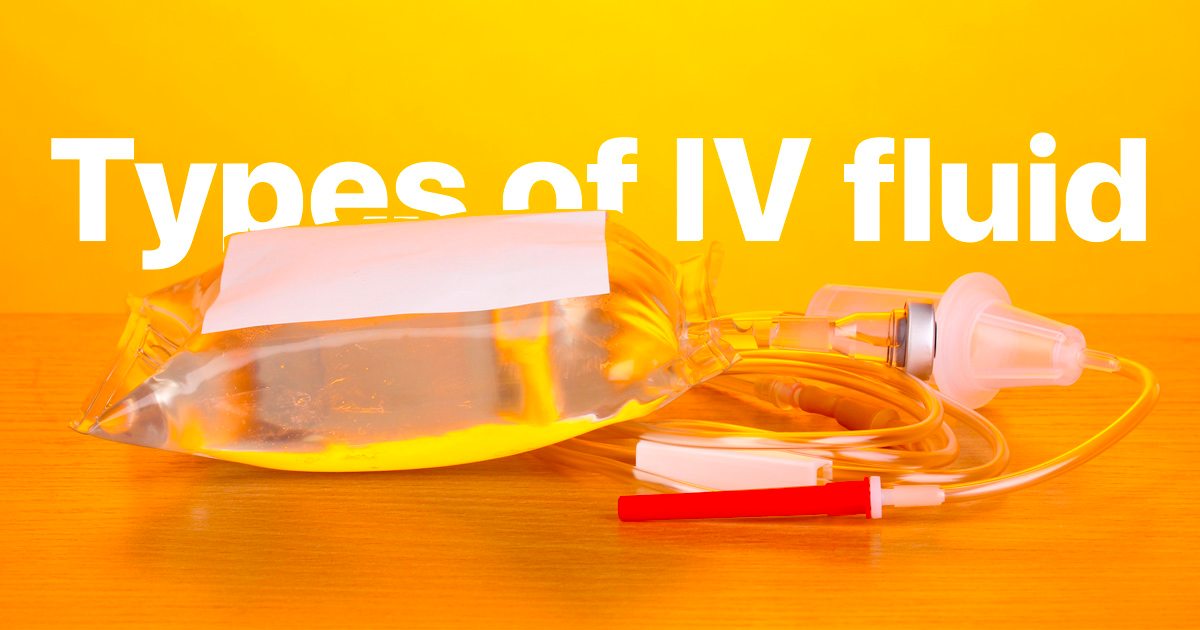
Content:
IV Fluids Types
What are IV Fluids?
- Intravenous fluids, also known as intravenous solutions, are supplemental fluids used in intravenous therapy to restore or maintain normal fluid volume and electrolyte balance when the oral route is impossible.
- IV fluid therapy is an efficient and effective way of supplying fluids directly into the intravascular fluid compartment, replacing electrolyte losses, and administering medications and blood products.
Types of IV Fluids
- There are different types of IV fluids and ways to classify them.
The most common way to categorise IV fluids is based on their tonicity:

- Isotonic IV solutions have the same solute concentration as blood plasma.
- Hypotonic. Hypotonic solutions have a lesser concentration of solutes than plasma.
- Hypertonic solutions have a greater concentration of solutes than plasma.
IV solutions can also be classified based on their purpose:
- Nutrient solutions. It may contain dextrose, glucose, and levulose to make up the carbohydrate component – and water. Water is supplied for fluid requirements and carbohydrates for calories and energy. Nutrient solutions help prevent dehydration and ketosis. Examples of nutrient solutions include D5W and D5NSS.
- Electrolyte solutions. Contains varying amounts of cations and anions used to replace fluid and electrolytes for clients with continuing losses. Examples of electrolyte solutions include 0.9 NaCl, Ringer’s Solution, and LRS.
- Alkalinising solutions. They are administered to treat metabolic acidosis. Examples: LRS.
- Acidifying solutions. They are used to counteract metabolic alkalosis. D51/2NS, 0.9 NaCl.
- Volume expanders. Are solutions used to increase the blood volume after a severe blood loss or loss of plasma? Examples of volume expanders are dextran, human albumin, and plasma.
Crystalloids
- Crystalloid IV solutions contain tiny molecules that flow easily across semipermeable membranes. They are categorised according to their relative tonicity in plasma. There are three types: isotonic, hypotonic, and hypertonic.
Isotonic IV Fluids
- Most IV fluids are isotonic, meaning they have the same concentration of solutes as blood plasma. When infused, isotonic solutions expand the intracellular and extracellular fluid spaces equally.
- Such fluids do not alter the osmolality of the vascular compartment.
- Technically, electrolyte solutions are considered isotonic if the total electrolyte content is approximately 310 mEq/L.
- Isotonic IV fluids have a total osmolality close to the ECF and do not cause red blood cells to shrink or swell.
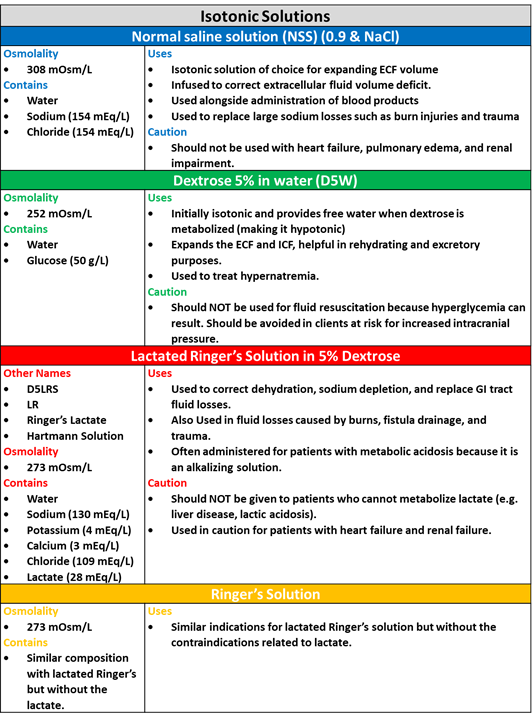
9% NaCl (Normal Saline Solution, NSS)
- Normal saline solution (0.9% NaCl) or NSS is a crystalloid isotonic IV fluid that contains water, sodium (154 mEq/L), and chloride (154 mEq/L).
- It has an osmolality of 308 mOsm/L and gives no calories. It is a standard saline solution because the percentage of sodium chloride dissolved in the solution is similar to the average concentration of sodium and chloride in the intravascular space.
- Normal saline is the isotonic solution for expanding the extracellular fluid (ECF) volume because it does not enter the intracellular fluid (ICF).
- It is administered to correct extracellular fluid volume deficit because it remains within the ECF.
- Normal saline is the IV fluid used alongside the administration of blood products.
- Additionally, used to replace significant sodium losses, such as in burn injuries and trauma.
- It should not be used for heart failure, pulmonary oedema, renal impairment, or conditions that cause sodium retention, as it may risk fluid volume overload.
Dextrose 5% in Water (D5W)
- D5W (dextrose 5% in water) is a crystalloid isotonic IV fluid with a serum osmolality of 252 mOsm/L.
- D5W is initially an isotonic solution and provides free water when dextrose is metabolised (making it a hypotonic solution), expanding the ECF and the ICF.
- It is administered to supply water and to correct an increase in serum osmolality.
- A litre of D5W provides fewer than 200 kcal and contains 50g of glucose.
- It should not used for fluid resuscitation because hyperglycemia can result.
- It should also avoided to be used in clients at risk for increased intracranial pressure as it can cause cerebral oedema.
Lactated Ringer’s 5% Dextrose in Water (D5LRS)
- Lactated Ringer’s Solution (also known as Ringer’s Lactate or Hartmann solution) is a crystalloid isotonic IV fluid designed to be the near-physiological solution of balanced electrolytes.
- It contains 130 mEq/L of sodium, four mEq/L of potassium, three mEq/L of calcium, and 109 mEq/L of chloride.
- In addition, it contains bicarbonate precursors to prevent acidosis.
- Moreover, it does not provide calories or magnesium and has limited potassium replacement.
- Additionally, it is the most physiologically adaptable fluid because its electrolyte content is closely related to the body’s blood serum and plasma composition.
- Lactated Ringer’s is used to correct dehydration and sodium depletion and replace GI tract fluid losses.
- Moreover, it can also used in fluid losses due to burns, fistula drainage, and trauma.
- It is the choice for first-line fluid resuscitation for certain patients. It is often administered to patients with metabolic acidosis.
- Lactated Ringer’s solution is metabolised in the liver, which converts the lactate to bicarbonate. Therefore, it should not give to patients who cannot metabolise lactate (e.g., liver disease, lactic acidosis).
- It should used with caution for patients with heart failure and renal failure.
Ringer’s Solution
- Ringer’s solution is another isotonic IV solution with content similar to Lactated Ringer’s Solution but does not contain lactate.
- Indications are the same for Lactated Ringer’s but without the contraindications related to lactate.
Hypotonic IV Fluids
- Hypotonic IV solutions have a lower osmolality and contain fewer solutes than plasma.
- They cause fluid shifts from the ECF into the ICF to achieve homeostasis, causing cells to swell and even rupture.
- IV solutions considered hypotonic if the total electrolyte content is less than 250 mEq/L.
- Hypotonic IV fluids are usually used to provide free water for the excretion of body wastes, treat cellular dehydration, and replace the cellular fluid.
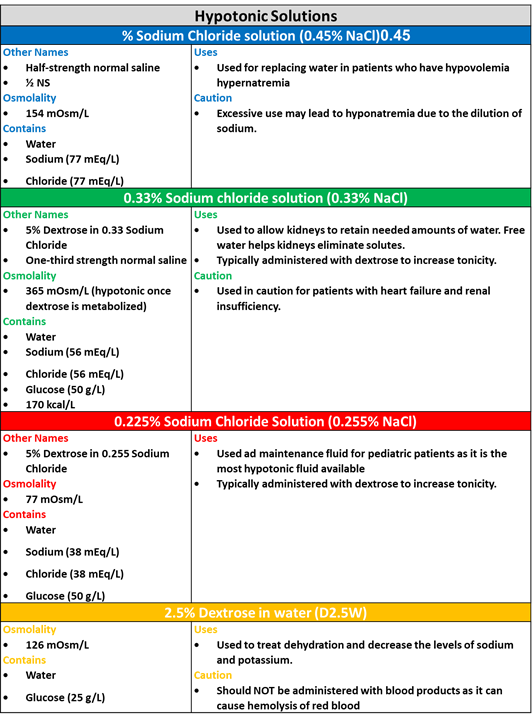
45% Sodium Chloride (0.45% NaCl)
- Sodium chloride 0.45% (1/2 NS), also known as half-strength normal saline, is a hypotonic IV solution used to replace the water in patients with hypovolemia hypernatremia.
- Excess use may lead to hyponatremia due to the dilution of sodium, especially in patients prone to water retention.
- It has an osmolality of 154 mOsm/L and contains 77 mEq/L sodium and chloride.
- Hypotonic sodium solutions are used to treat hypernatremia and other hyperosmolar conditions.
33% Sodium Chloride (0.33% NaCl)
- 0.33% Sodium Chloride Solution used to allow kidneys to retain the needed amounts of water and typically administered with dextrose to increase tonicity.
- So, used in caution for patients with heart failure and renal insufficiency.
225% Sodium Chloride (0.225% NaCl)
- 0.225% Sodium Chloride Solution used as a maintenance fluid for pediatric patients as it is the most hypotonic IV fluid available at 77 mOsm/L. Used together with dextrose.
5% Dextrose in Water (D2.5W)
- Another standard hypotonic IV solution is 2.5% dextrose in water (D2.5W).
- This solution used to treat dehydration and decrease sodium and potassium levels.
- Do not administer with blood products as it can cause hemolysis of red blood cells.
1. Hypertonic IV Fluids
- Hypertonic IV solutions have a greater concentration of solutes (375 mEq/L and more significant) than the plasma and cause fluids to move out of the cells and into the ECF to normalise the concentration of particles between two compartments.
- This effect causes cells to shrink and may disrupt their function.
- Additionally, known as volume expanders as they draw water out of the intracellular space, increasing extracellular fluid volume.
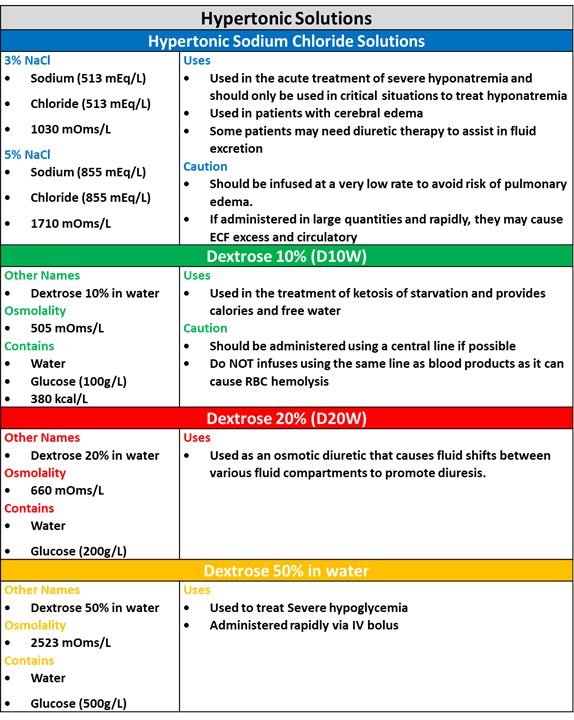
2. Hypertonic Sodium Chloride IV Fluids
- Hypertonic sodium chloride solutions contain a higher concentration of sodium and chloride than typically contained in plasma.
- Infusion of hypertonic sodium chloride solution shifts fluids from the intracellular space into the intravascular and interstitial spaces.
- Hypertonic sodium chloride IV solutions are available in the following forms and strengths:
- 3% sodium chloride (3% NaCl) containing 513 mEq/L of sodium and chloride with an osmolality of 1030 mOsm/L.
- 5% sodium chloride (5% NaCl) containing 855 mEq/L of sodium and chloride with an osmolality of 1710 mOsm/L.
- Hypertonic sodium chloride solutions used in the acute treatment of sodium deficiency (severe hyponatremia).
- Additionally, used only in critical situations to treat hyponatremia.
- They need to infuse at a meagre rate to avoid the risk of overload and pulmonary oedema.
- If administered in large quantities and rapidly, they may cause an extracellular volume excess and precipitate circulatory overload and dehydration.
- Therefore, administered cautiously and usually only when the serum osmolality has decreased to critically low levels.
- Some patients may need diuretic therapy to assist in fluid excretion. It also used in patients with cerebral oedema.
3. Hypertonic Dextrose Solutions
- Isotonic solutions that contain 5% dextrose (e.g., D5NSS, D5LRS) are slightly hypertonic since they exceed the total osmolality of the ECF.
- However, dextrose quickly metabolised, and only the isotonic solution remains. Therefore, any effect on the ICF is temporary.
- Hypertonic dextrose solutions used to provide kilocalories for the patient in the short term.
- Higher concentrations of dextrose (i.e., D50W) are solid hypertonic solutions.
- Moreover, they are administered into central veins so that they dilute by rapid blood flow.
4. Dextrose 10% in Water (D10W)
- Doctors use Dextrose 10% in Water (D10W) as a hypertonic IV solution to treat ketosis of starvation and provide calories (380 kcal/L), free water, and no electrolytes.
- Additionally, they can administer using a central line and do not infuse D10W, using the same line as blood products, as it can cause RBC hemolysis.
5. Dextrose 20% in Water (D20W)
- The Dextrose 20% in Water (D20W) is a hypertonic IV solution, an osmotic diuretic that causes fluid shifts between various compartments to promote diuresis.
6. The Dextrose 50% in Water (D50W)
- Another standard hypertonic IV solution is Dextrose 50% in Water (D50W).
- Doctors use it to treat severe hypoglycemia, and nurses administer it rapidly via IV bolus.
Colloids
- Colloids contain large molecules that do not pass through semipermeable membranes.
- The colloids are IV fluids that contain solutes of high molecular weight; technically, they are hypertonic solutions, which, when infused, exert an osmotic pull of fluids from interstitial and extracellular spaces.
- They help expand the intravascular volume and raise blood pressure.
- In addition, colloids indicated for patients in malnourished states and patients who cannot tolerate large fluid infusions.
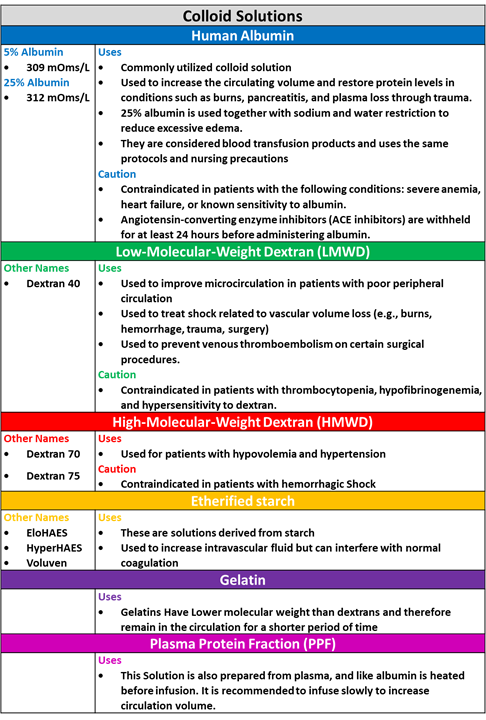
Human Albumin
- Human albumin derived from plasma.
- It has two strengths: 5% albumin and 25% albumin.
- 5% Albumin, a solution derived from plasma and a commonly utilised colloid solution.
- Then, used to increase the circulating volume and restore protein levels in conditions such as burns, pancreatitis, and plasma loss through trauma.
- 25% Albumin used together with sodium and water restriction to reduce excessive oedema.
- In addition to considering blood transfusion products and using the same protocols and nursing precautions when administering albumin.
- The use of albumin contraindicated in patients with the following conditions: severe anaemia, heart failure, or known sensitivity to albumin.
- Additionally, angiotensin-converting enzyme inhibitors can withheld for at least 24 hours before administering albumin because of the risk of atypical reactions, such as hypotension and flushing.
Dextrans
- Dextrans are polysaccharides that act as colloids.
- They are available in low-molecular-weight dextrans (LMWD) and high-molecular-weight dextrans (HMWD).
- They are available in either saline or glucose solutions.
- Dextran interferes with blood crossmatching, so draw the patient’s blood before administering dextran if crossmatching anticipated.
Low-molecular-weight Dextrans (LMWD)
- LMWD contains polysaccharide molecules that behave like colloids with an average molecular weight of 40,000 (Dextran 40).
- LMWD used to improve microcirculation in patients with poor peripheral circulation. They contain no electrolytes.
- In addition, use it to treat shock related to vascular volume loss (e.g., burns, bleeding, trauma, or surgery).
- For specific surgical procedures, LMWDs used to prevent venous thromboembolism.
- Additionally, The LMWDs contraindicated in patients with thrombocytopenia, hypofibrinogenemia, and hypersensitivity to dextran.
High-molecular-weight Dextrans (HMWD)
- HMWD contains polysaccharide molecules with an average molecular weight of 70,000 (Dextran 70) or 75,000 (Dextran 75).
- HMWD used for patients with hypovolemia and hypotension.
- They contraindicated in patients with hemorrhagic shock.
Etherified Starch
- These solutions derived from starch and used to increase intravascular fluid but can interfere with normal coagulation.
- Examples include EloHAES, HyperHAES, and Volume.
Gelatin
- Gelatins have a lower molecular weight than dextrans and remain in circulation for a shorter period.
Plasma Protein Fraction (PPF)
- Plasma Protein Fraction is a solution that also prepared from plasma.
- Finally, like albumin, heated before infusion. So, recommended infusing slowly to increase circulating volume.
IV fluid Comparison
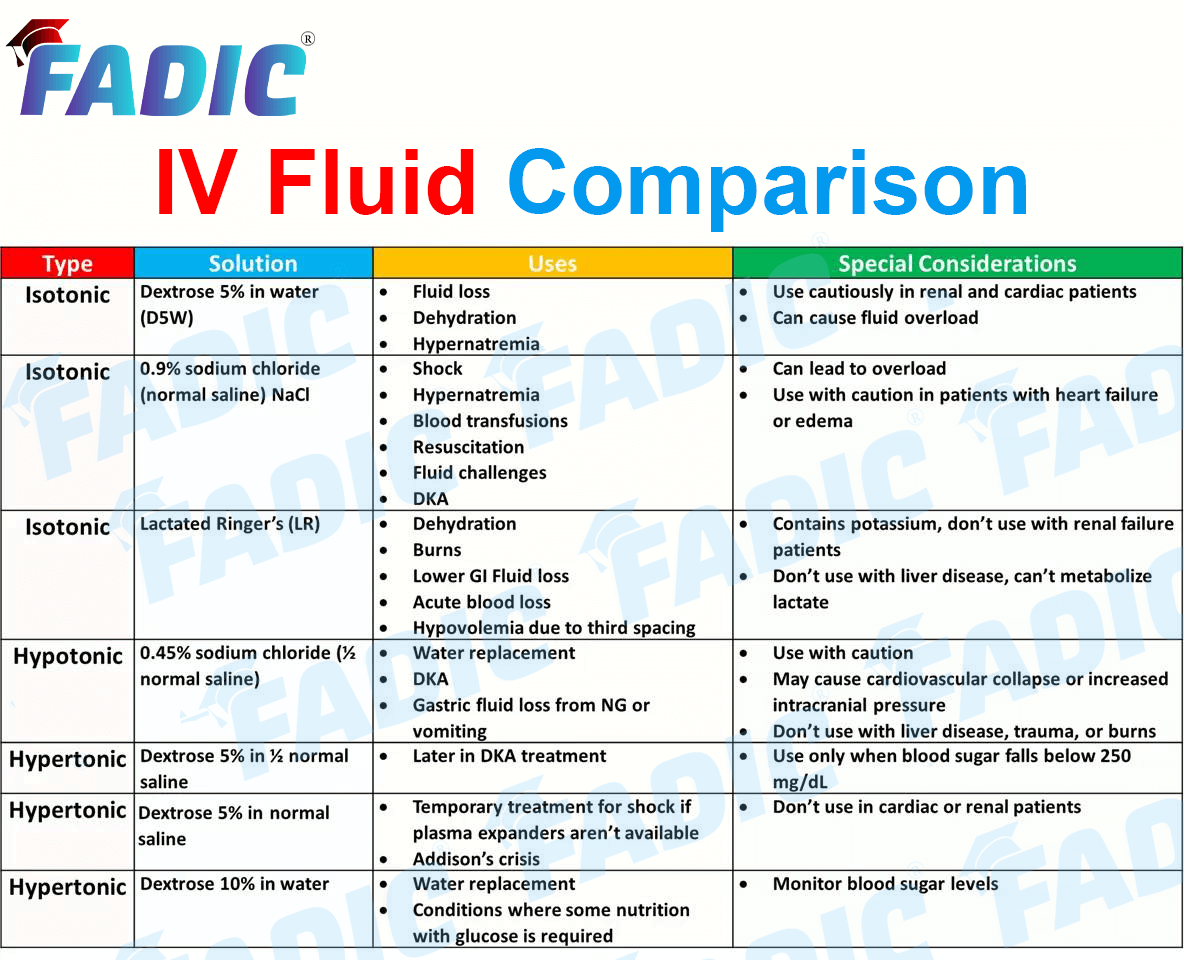
Conclusion
- IV fluid therapy is an efficient and effective way of supplying fluids directly into the intravascular fluid compartment.
- There are different types of IV fluids and ways to classify them.
Read More:
- Antimicrobial Stewardship School
- Sepsis Training Program
- Download Pocket Guide for Antibiotic Pharmacotherapy Book
- Microbiology Course | ABC Bacteria
- Infectious Disease E-News | FREE Subscription
- ABC antimicrobials | Know all about the Antimicrobials
- Road Map to Antimicrobial Stewardship Training Program
- Register Now at FADIC Clinical Research School
- FADIC Drug Information Fellowship
- Buy FADIC Toolkit for Writing Research to Write a Great Research Paper
- Read 10 Skills You Must Learn to Do Research via Google Scholar in Arabic
- The FADIC Online Continuous Medical Improvement Programs & Mini-Courses.
- Check Now the FADIC Book store and Buy books in different specialities.
- Watch Now FADIC TV to Keep Yourself Updated.
- FADIC Podcast focuses on varieties of pharmacist perspectives in different specialities.
- Subscribe Now to FADIC 2020 Daily News (FNN) and Keep Updated.
- Check Now about Coronavirus Resource Information Center.

 Log in
Log in Sign up
Sign up